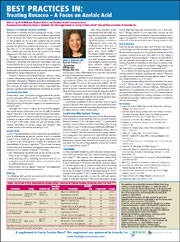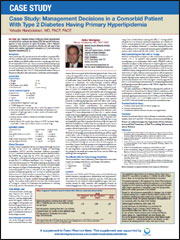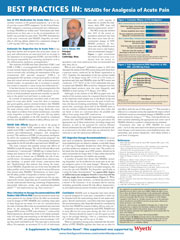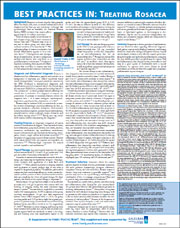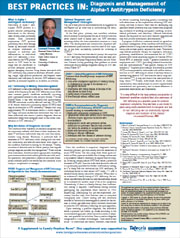User login
Touchscreen Medicine
Mobile technology, such as tablet computers, Internet-enabled smartphones, and the applications both devices use, will change the face of HM and other physician specialties, one medical software executive says.
"Mobile technology will improve efficiency and reduce costs," Mark Cain, chief technology officer of MIM Software Inc., writes in an e-mail to The Hospitalist. "Compare the cost of an iPad to that of an exam room PC. If I was making the decision, I'd find a way to remove every exam room PC [with their keyboards, CPUs, mice, monitors, and network cables] and instead supply iPads to be carried by the staff. With a good Wi-Fi network and iPads, every room is digitally equipped as soon as the doctor walks in."
Cain has seen the paradigm shift of touchscreen technology firsthand: The FDA recently approved an application from Cleveland-based MIM to let doctors make medical diagnoses based on computed tomography (CT) and magnetic resonance imaging (MRI) via an application available for the iPhone and iPad. The application, the first with the FDA's imprimatur for diagnostic radiology, allows hospitalists and other physicians to access data via a secure network transfer.
The app for that is just the latest sign that the growing prevalence of touchscreen technology is changing the face of HM.
The evolution has its pitfalls, though. Patient privacy, wireless security, and the hesitancy of physicians to adopt change will likely slow the adoption of technology, but "the integration of interactive devices into a physician's daily workflow could become as commonplace in 10 years as the presence of hospitalists is today," Cain says.
Mobile technology, such as tablet computers, Internet-enabled smartphones, and the applications both devices use, will change the face of HM and other physician specialties, one medical software executive says.
"Mobile technology will improve efficiency and reduce costs," Mark Cain, chief technology officer of MIM Software Inc., writes in an e-mail to The Hospitalist. "Compare the cost of an iPad to that of an exam room PC. If I was making the decision, I'd find a way to remove every exam room PC [with their keyboards, CPUs, mice, monitors, and network cables] and instead supply iPads to be carried by the staff. With a good Wi-Fi network and iPads, every room is digitally equipped as soon as the doctor walks in."
Cain has seen the paradigm shift of touchscreen technology firsthand: The FDA recently approved an application from Cleveland-based MIM to let doctors make medical diagnoses based on computed tomography (CT) and magnetic resonance imaging (MRI) via an application available for the iPhone and iPad. The application, the first with the FDA's imprimatur for diagnostic radiology, allows hospitalists and other physicians to access data via a secure network transfer.
The app for that is just the latest sign that the growing prevalence of touchscreen technology is changing the face of HM.
The evolution has its pitfalls, though. Patient privacy, wireless security, and the hesitancy of physicians to adopt change will likely slow the adoption of technology, but "the integration of interactive devices into a physician's daily workflow could become as commonplace in 10 years as the presence of hospitalists is today," Cain says.
Mobile technology, such as tablet computers, Internet-enabled smartphones, and the applications both devices use, will change the face of HM and other physician specialties, one medical software executive says.
"Mobile technology will improve efficiency and reduce costs," Mark Cain, chief technology officer of MIM Software Inc., writes in an e-mail to The Hospitalist. "Compare the cost of an iPad to that of an exam room PC. If I was making the decision, I'd find a way to remove every exam room PC [with their keyboards, CPUs, mice, monitors, and network cables] and instead supply iPads to be carried by the staff. With a good Wi-Fi network and iPads, every room is digitally equipped as soon as the doctor walks in."
Cain has seen the paradigm shift of touchscreen technology firsthand: The FDA recently approved an application from Cleveland-based MIM to let doctors make medical diagnoses based on computed tomography (CT) and magnetic resonance imaging (MRI) via an application available for the iPhone and iPad. The application, the first with the FDA's imprimatur for diagnostic radiology, allows hospitalists and other physicians to access data via a secure network transfer.
The app for that is just the latest sign that the growing prevalence of touchscreen technology is changing the face of HM.
The evolution has its pitfalls, though. Patient privacy, wireless security, and the hesitancy of physicians to adopt change will likely slow the adoption of technology, but "the integration of interactive devices into a physician's daily workflow could become as commonplace in 10 years as the presence of hospitalists is today," Cain says.
C. Diff Rates Rise for Hospitalized Children
An article in the upcoming May issue of Archives of Pediatrics and Adolescent Medicine tracks the growing incidence of Clostridium difficile bacterial infections in hospitalized children.
Cade M. Nylund, MD, assistant professor of pediatrics at the Uniformed Services University of the Health Sciences in Bethesda, Md., and colleagues analyzed a national database of children discharged from hospitals in 1997, 2000, 2003, and 2006. Of 10.5 million total cases, only 0.2% had C. diff infections, but the number of cases increased by about 15% per year.
Incidence, severity, and deaths from C. diff in adults have also been increasing. Unlike adults, however, the authors did not observe an increase in severity of the disease for children over this time period. Infection, however, was associated with increased risk of death, higher colectomy rates, longer hospital stays, and higher costs.
Dr. Nylund says it is difficult to explain why is increasing in hospitalized children, but it might reflect antibiotic treatment practices, since prior antibiotic exposure is considered a risk factor. It also could be due to a more virulent strain of C. diff commonly found in hospitals, or the fact that healthcare providers are more aware of the need to test symptomatic patients for this infection.
According to Dr. Nylund, pediatric hospitalists should be aware of the significant impact of C. diff. "These children are more likely to stay in the hospital or die," he says. He suggests paying attention to such risk factors as antibiotic use, immune system suppression, and persistent diarrhea, as well as the need for a differential diagnosis. Appropriate and early isolation is important, as is hand-washing with soap and water, not using just alcohol-based hand gels, he adds.
"A lot of antibiotics are used to treat C. diff, some of them off-label," Dr. Nylund says. "I get phone consults, typically for difficult, recurring, and chronic cases. It seems like I'm receiving those calls more frequently."
For more information on treatment of C. diff, check out the Key Clinical Question in the March 2009 issue of The Hospitalist.
An article in the upcoming May issue of Archives of Pediatrics and Adolescent Medicine tracks the growing incidence of Clostridium difficile bacterial infections in hospitalized children.
Cade M. Nylund, MD, assistant professor of pediatrics at the Uniformed Services University of the Health Sciences in Bethesda, Md., and colleagues analyzed a national database of children discharged from hospitals in 1997, 2000, 2003, and 2006. Of 10.5 million total cases, only 0.2% had C. diff infections, but the number of cases increased by about 15% per year.
Incidence, severity, and deaths from C. diff in adults have also been increasing. Unlike adults, however, the authors did not observe an increase in severity of the disease for children over this time period. Infection, however, was associated with increased risk of death, higher colectomy rates, longer hospital stays, and higher costs.
Dr. Nylund says it is difficult to explain why is increasing in hospitalized children, but it might reflect antibiotic treatment practices, since prior antibiotic exposure is considered a risk factor. It also could be due to a more virulent strain of C. diff commonly found in hospitals, or the fact that healthcare providers are more aware of the need to test symptomatic patients for this infection.
According to Dr. Nylund, pediatric hospitalists should be aware of the significant impact of C. diff. "These children are more likely to stay in the hospital or die," he says. He suggests paying attention to such risk factors as antibiotic use, immune system suppression, and persistent diarrhea, as well as the need for a differential diagnosis. Appropriate and early isolation is important, as is hand-washing with soap and water, not using just alcohol-based hand gels, he adds.
"A lot of antibiotics are used to treat C. diff, some of them off-label," Dr. Nylund says. "I get phone consults, typically for difficult, recurring, and chronic cases. It seems like I'm receiving those calls more frequently."
For more information on treatment of C. diff, check out the Key Clinical Question in the March 2009 issue of The Hospitalist.
An article in the upcoming May issue of Archives of Pediatrics and Adolescent Medicine tracks the growing incidence of Clostridium difficile bacterial infections in hospitalized children.
Cade M. Nylund, MD, assistant professor of pediatrics at the Uniformed Services University of the Health Sciences in Bethesda, Md., and colleagues analyzed a national database of children discharged from hospitals in 1997, 2000, 2003, and 2006. Of 10.5 million total cases, only 0.2% had C. diff infections, but the number of cases increased by about 15% per year.
Incidence, severity, and deaths from C. diff in adults have also been increasing. Unlike adults, however, the authors did not observe an increase in severity of the disease for children over this time period. Infection, however, was associated with increased risk of death, higher colectomy rates, longer hospital stays, and higher costs.
Dr. Nylund says it is difficult to explain why is increasing in hospitalized children, but it might reflect antibiotic treatment practices, since prior antibiotic exposure is considered a risk factor. It also could be due to a more virulent strain of C. diff commonly found in hospitals, or the fact that healthcare providers are more aware of the need to test symptomatic patients for this infection.
According to Dr. Nylund, pediatric hospitalists should be aware of the significant impact of C. diff. "These children are more likely to stay in the hospital or die," he says. He suggests paying attention to such risk factors as antibiotic use, immune system suppression, and persistent diarrhea, as well as the need for a differential diagnosis. Appropriate and early isolation is important, as is hand-washing with soap and water, not using just alcohol-based hand gels, he adds.
"A lot of antibiotics are used to treat C. diff, some of them off-label," Dr. Nylund says. "I get phone consults, typically for difficult, recurring, and chronic cases. It seems like I'm receiving those calls more frequently."
For more information on treatment of C. diff, check out the Key Clinical Question in the March 2009 issue of The Hospitalist.
Horse ATG for Severe Aplastic Anemia
Rabbit antithymocyte globulin (ATG) was inferior to horse ATG for the initial treatment of patients with severe aplastic anemia, Dr. Phillip Scheinberg says. See the related story at http://tinyurl.com/5r9wrmz
Rabbit antithymocyte globulin (ATG) was inferior to horse ATG for the initial treatment of patients with severe aplastic anemia, Dr. Phillip Scheinberg says. See the related story at http://tinyurl.com/5r9wrmz
Rabbit antithymocyte globulin (ATG) was inferior to horse ATG for the initial treatment of patients with severe aplastic anemia, Dr. Phillip Scheinberg says. See the related story at http://tinyurl.com/5r9wrmz
HM Improves Quality in Singapore
The HM model has solidified its global status.
A group of family physicians in Singapore studied the implementation of a hospitalist program at Singapore General Hospital, according to a Journal of Hospital Medicine report. The researchers found that, compared with patients under the care of specialists, those cared for by hospitalists had shorter lengths of stay (adjusted LOS, geometric mean, GM 4.4 vs. 5.3 days; P<0.001) and reduced costs (adjusted cost, GM, $2,250.70 vs. $2,500; P=0.003). The researchers also found a similar inpatient mortality rate (4.2% vs. 5.3%, P=0.307) and 30-day all-cause unscheduled readmission rate (7.5% vs. 8.4%, P=0.231).
"These findings suggest that the hospitalist care model can be adapted for health systems outside North America and may produce similar beneficial effects in care efficiency and cost savings," the authors concluded.
The initiative in Singapore, a city-state in Southeast Asia with a population close to 5 million, is not the first adoption of the HM model outside the U.S. But the data showing reduced LOS and costs is further evidence of both the growth and the efficacy of the HM movement worldwide, says Kheng Hock Lee, MBBS, MMed, FCFP, one of the study authors.
"Our study showed very similar improvement in care outcomes with hospitalist programs in the United States, although we are thousands of miles apart and with a different culture and healthcare system," Kheng Hock wrote in an e-mail to The Hospitalist eWire. "I think the success of the hospitalist care model stems from the recognition that it fulfills an emergent need that has resulted from the increase in complexity of healthcare and the need for specialization in medicine.
"The need for a good generalist in the hospital setting who can coordinate care and treat patient holistically is intuitively recognized by policymakers, healthcare providers, and patients."
The HM model has solidified its global status.
A group of family physicians in Singapore studied the implementation of a hospitalist program at Singapore General Hospital, according to a Journal of Hospital Medicine report. The researchers found that, compared with patients under the care of specialists, those cared for by hospitalists had shorter lengths of stay (adjusted LOS, geometric mean, GM 4.4 vs. 5.3 days; P<0.001) and reduced costs (adjusted cost, GM, $2,250.70 vs. $2,500; P=0.003). The researchers also found a similar inpatient mortality rate (4.2% vs. 5.3%, P=0.307) and 30-day all-cause unscheduled readmission rate (7.5% vs. 8.4%, P=0.231).
"These findings suggest that the hospitalist care model can be adapted for health systems outside North America and may produce similar beneficial effects in care efficiency and cost savings," the authors concluded.
The initiative in Singapore, a city-state in Southeast Asia with a population close to 5 million, is not the first adoption of the HM model outside the U.S. But the data showing reduced LOS and costs is further evidence of both the growth and the efficacy of the HM movement worldwide, says Kheng Hock Lee, MBBS, MMed, FCFP, one of the study authors.
"Our study showed very similar improvement in care outcomes with hospitalist programs in the United States, although we are thousands of miles apart and with a different culture and healthcare system," Kheng Hock wrote in an e-mail to The Hospitalist eWire. "I think the success of the hospitalist care model stems from the recognition that it fulfills an emergent need that has resulted from the increase in complexity of healthcare and the need for specialization in medicine.
"The need for a good generalist in the hospital setting who can coordinate care and treat patient holistically is intuitively recognized by policymakers, healthcare providers, and patients."
The HM model has solidified its global status.
A group of family physicians in Singapore studied the implementation of a hospitalist program at Singapore General Hospital, according to a Journal of Hospital Medicine report. The researchers found that, compared with patients under the care of specialists, those cared for by hospitalists had shorter lengths of stay (adjusted LOS, geometric mean, GM 4.4 vs. 5.3 days; P<0.001) and reduced costs (adjusted cost, GM, $2,250.70 vs. $2,500; P=0.003). The researchers also found a similar inpatient mortality rate (4.2% vs. 5.3%, P=0.307) and 30-day all-cause unscheduled readmission rate (7.5% vs. 8.4%, P=0.231).
"These findings suggest that the hospitalist care model can be adapted for health systems outside North America and may produce similar beneficial effects in care efficiency and cost savings," the authors concluded.
The initiative in Singapore, a city-state in Southeast Asia with a population close to 5 million, is not the first adoption of the HM model outside the U.S. But the data showing reduced LOS and costs is further evidence of both the growth and the efficacy of the HM movement worldwide, says Kheng Hock Lee, MBBS, MMed, FCFP, one of the study authors.
"Our study showed very similar improvement in care outcomes with hospitalist programs in the United States, although we are thousands of miles apart and with a different culture and healthcare system," Kheng Hock wrote in an e-mail to The Hospitalist eWire. "I think the success of the hospitalist care model stems from the recognition that it fulfills an emergent need that has resulted from the increase in complexity of healthcare and the need for specialization in medicine.
"The need for a good generalist in the hospital setting who can coordinate care and treat patient holistically is intuitively recognized by policymakers, healthcare providers, and patients."
“Smart Bed” Could Improve Efficiency
John LaCourse, PhD, professor and chair of the University of New Hampshire's Department of Electrical and Computer Engineering, has developed an algorithm to create a "smart" hospital bed that will communicate with other devices (i.e. X-rays or blood-pressure monitors) to monitor a patient's health and automatically make necessary adjustments.
To connect the small computers built into medical devices and avoid patent infringement, Dr. LaCourse plans to use a CANopen system, a common bus, or communication zone. If medical equipment manufacturers approve, the software can be implemented without any modifications to standard hospital beds.
"Medical errors are generated because devices don't talk to each other," LaCourse says. "What we're trying to do is break down that wall, work with the manufacturers, and see if we could get the common bus to be used."
For example, the "smart" beds could be used to measure and reduce the risks of apnea: If the bed determines that a patient ceases breathing, it will automatically change positions until the condition improves. LaCourse, however, envisions the beds having a "broad use," including blood-pressure measurements and respiratory and X-ray analyses, both in hospitals and homecare situations.
Anuj K. Dalal, MD, FHM, a hospitalist at Brigham and Women's Hospital in Boston, says "smart" beds are "an interesting concept."
"There is definitely interest in people trying to figure out how to monitor a patient’s status in real time," he says.
However, Dr. Dalal notes, there are potential consequences of relying too heavily on technology: "There can be a whole host of readings why the blood pressure drops. Moving the bed around could improve the readings, but it may not necessarily mean it’s improving the patient."
John LaCourse, PhD, professor and chair of the University of New Hampshire's Department of Electrical and Computer Engineering, has developed an algorithm to create a "smart" hospital bed that will communicate with other devices (i.e. X-rays or blood-pressure monitors) to monitor a patient's health and automatically make necessary adjustments.
To connect the small computers built into medical devices and avoid patent infringement, Dr. LaCourse plans to use a CANopen system, a common bus, or communication zone. If medical equipment manufacturers approve, the software can be implemented without any modifications to standard hospital beds.
"Medical errors are generated because devices don't talk to each other," LaCourse says. "What we're trying to do is break down that wall, work with the manufacturers, and see if we could get the common bus to be used."
For example, the "smart" beds could be used to measure and reduce the risks of apnea: If the bed determines that a patient ceases breathing, it will automatically change positions until the condition improves. LaCourse, however, envisions the beds having a "broad use," including blood-pressure measurements and respiratory and X-ray analyses, both in hospitals and homecare situations.
Anuj K. Dalal, MD, FHM, a hospitalist at Brigham and Women's Hospital in Boston, says "smart" beds are "an interesting concept."
"There is definitely interest in people trying to figure out how to monitor a patient’s status in real time," he says.
However, Dr. Dalal notes, there are potential consequences of relying too heavily on technology: "There can be a whole host of readings why the blood pressure drops. Moving the bed around could improve the readings, but it may not necessarily mean it’s improving the patient."
John LaCourse, PhD, professor and chair of the University of New Hampshire's Department of Electrical and Computer Engineering, has developed an algorithm to create a "smart" hospital bed that will communicate with other devices (i.e. X-rays or blood-pressure monitors) to monitor a patient's health and automatically make necessary adjustments.
To connect the small computers built into medical devices and avoid patent infringement, Dr. LaCourse plans to use a CANopen system, a common bus, or communication zone. If medical equipment manufacturers approve, the software can be implemented without any modifications to standard hospital beds.
"Medical errors are generated because devices don't talk to each other," LaCourse says. "What we're trying to do is break down that wall, work with the manufacturers, and see if we could get the common bus to be used."
For example, the "smart" beds could be used to measure and reduce the risks of apnea: If the bed determines that a patient ceases breathing, it will automatically change positions until the condition improves. LaCourse, however, envisions the beds having a "broad use," including blood-pressure measurements and respiratory and X-ray analyses, both in hospitals and homecare situations.
Anuj K. Dalal, MD, FHM, a hospitalist at Brigham and Women's Hospital in Boston, says "smart" beds are "an interesting concept."
"There is definitely interest in people trying to figure out how to monitor a patient’s status in real time," he says.
However, Dr. Dalal notes, there are potential consequences of relying too heavily on technology: "There can be a whole host of readings why the blood pressure drops. Moving the bed around could improve the readings, but it may not necessarily mean it’s improving the patient."
BEST PRACTICES IN: Treating Rosacea - A Focus on Azelaic Acid
A supplement to Family Practice News. This supplement was sponsored by Intendis, Inc.
Written by Ruth Williams, Medical Writer, and Medisys Health Communications, LLC, on behalf of Intendis, Inc.
•Topics
•Faculty/Faculty Disclosures
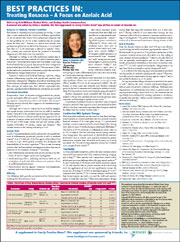
To view the supplement, click the image above.
Topics
• Rosacea: A Common, Chronic Condition
• Treatment Essentials
• Azelaic Acid
• Efficacy
• Combination With Systemic Therapy
• Tolerability
• AzA in Practice
Faculty/Faculty Disclosure
Hilary E. Baldwin, MD
Associate Professor of Dermatology
SUNY-Brooklyn
Brooklyn, New York
Dr Baldwin is a Consultant/Advisory Board/ Speakers' Bureau member of Allergan, Inc., Coria Laboratories Ltd, Galderma Laboratories, L.P., GlaxoSmithKline, Intendis, Inc., Medicis Pharmaceutical Corporation, OrthoNeutrogena, Ranbaxy Pharmaceuticals, sanofi-aventis, and Stiefel Laboratories.
Copyright © 2010 Elsevier Inc.
A supplement to Family Practice News. This supplement was sponsored by Intendis, Inc.
Written by Ruth Williams, Medical Writer, and Medisys Health Communications, LLC, on behalf of Intendis, Inc.
•Topics
•Faculty/Faculty Disclosures

To view the supplement, click the image above.
Topics
• Rosacea: A Common, Chronic Condition
• Treatment Essentials
• Azelaic Acid
• Efficacy
• Combination With Systemic Therapy
• Tolerability
• AzA in Practice
Faculty/Faculty Disclosure
Hilary E. Baldwin, MD
Associate Professor of Dermatology
SUNY-Brooklyn
Brooklyn, New York
Dr Baldwin is a Consultant/Advisory Board/ Speakers' Bureau member of Allergan, Inc., Coria Laboratories Ltd, Galderma Laboratories, L.P., GlaxoSmithKline, Intendis, Inc., Medicis Pharmaceutical Corporation, OrthoNeutrogena, Ranbaxy Pharmaceuticals, sanofi-aventis, and Stiefel Laboratories.
Copyright © 2010 Elsevier Inc.
A supplement to Family Practice News. This supplement was sponsored by Intendis, Inc.
Written by Ruth Williams, Medical Writer, and Medisys Health Communications, LLC, on behalf of Intendis, Inc.
•Topics
•Faculty/Faculty Disclosures

To view the supplement, click the image above.
Topics
• Rosacea: A Common, Chronic Condition
• Treatment Essentials
• Azelaic Acid
• Efficacy
• Combination With Systemic Therapy
• Tolerability
• AzA in Practice
Faculty/Faculty Disclosure
Hilary E. Baldwin, MD
Associate Professor of Dermatology
SUNY-Brooklyn
Brooklyn, New York
Dr Baldwin is a Consultant/Advisory Board/ Speakers' Bureau member of Allergan, Inc., Coria Laboratories Ltd, Galderma Laboratories, L.P., GlaxoSmithKline, Intendis, Inc., Medicis Pharmaceutical Corporation, OrthoNeutrogena, Ranbaxy Pharmaceuticals, sanofi-aventis, and Stiefel Laboratories.
Copyright © 2010 Elsevier Inc.
CASE STUDY: Management Decisions in a Comorbid Patient With Type 2 Diabetes Having Primary Hyperlipidemia
A supplement to Family Practice News. This supplement was sponsored by Daiichi Sankyo, Inc.
•Topics
•Faculty/Faculty Disclosures
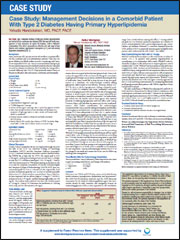
To view the supplement, click the image above.
Topics
• Background
• Current Visit
• Laboratory Results
• Clinical Discussion
• Endocrinologist Consultation
• New Treatment Regimen With Add-On Therapy
• Conclusions
Faculty
Yehuda Handelsman, MD, FACP, FACE
Medical Director, Metabolic Institute of America
Chair and Program Director, 7th World Congress on Insulin Resistance Chair, International Committee for Insulin Resistance
18372 Clark Street, Suite 212
Tarzana, CA 91356
E-mail:[email protected]
Web site:www.TheMetabolicCenter.com
Dr Handelsman is a consultant for Bristol-Myers Squibb Company, Daiichi Sankyo, Inc., GlaxoSmithKline, Medtronic, Merck, Xoma, and Tethys;he has received clinical research grant funding from Takeda, Daiichi Sankyo Inc., GlaxoSmithKline, and Novo Nordisk; and he is on the speakers bureau for AstraZeneca, Bristol-Myers Squibb, Daiichi Sankyo Inc., GlaxoSmithKline, Merck, and Novartis. He also serves on the advisory board for CLINICAL ENDOCRINOLOGY NEWS.
Copyright © 2010 Elsevier Inc.
A supplement to Family Practice News. This supplement was sponsored by Daiichi Sankyo, Inc.
•Topics
•Faculty/Faculty Disclosures

To view the supplement, click the image above.
Topics
• Background
• Current Visit
• Laboratory Results
• Clinical Discussion
• Endocrinologist Consultation
• New Treatment Regimen With Add-On Therapy
• Conclusions
Faculty
Yehuda Handelsman, MD, FACP, FACE
Medical Director, Metabolic Institute of America
Chair and Program Director, 7th World Congress on Insulin Resistance Chair, International Committee for Insulin Resistance
18372 Clark Street, Suite 212
Tarzana, CA 91356
E-mail:[email protected]
Web site:www.TheMetabolicCenter.com
Dr Handelsman is a consultant for Bristol-Myers Squibb Company, Daiichi Sankyo, Inc., GlaxoSmithKline, Medtronic, Merck, Xoma, and Tethys;he has received clinical research grant funding from Takeda, Daiichi Sankyo Inc., GlaxoSmithKline, and Novo Nordisk; and he is on the speakers bureau for AstraZeneca, Bristol-Myers Squibb, Daiichi Sankyo Inc., GlaxoSmithKline, Merck, and Novartis. He also serves on the advisory board for CLINICAL ENDOCRINOLOGY NEWS.
Copyright © 2010 Elsevier Inc.
A supplement to Family Practice News. This supplement was sponsored by Daiichi Sankyo, Inc.
•Topics
•Faculty/Faculty Disclosures

To view the supplement, click the image above.
Topics
• Background
• Current Visit
• Laboratory Results
• Clinical Discussion
• Endocrinologist Consultation
• New Treatment Regimen With Add-On Therapy
• Conclusions
Faculty
Yehuda Handelsman, MD, FACP, FACE
Medical Director, Metabolic Institute of America
Chair and Program Director, 7th World Congress on Insulin Resistance Chair, International Committee for Insulin Resistance
18372 Clark Street, Suite 212
Tarzana, CA 91356
E-mail:[email protected]
Web site:www.TheMetabolicCenter.com
Dr Handelsman is a consultant for Bristol-Myers Squibb Company, Daiichi Sankyo, Inc., GlaxoSmithKline, Medtronic, Merck, Xoma, and Tethys;he has received clinical research grant funding from Takeda, Daiichi Sankyo Inc., GlaxoSmithKline, and Novo Nordisk; and he is on the speakers bureau for AstraZeneca, Bristol-Myers Squibb, Daiichi Sankyo Inc., GlaxoSmithKline, Merck, and Novartis. He also serves on the advisory board for CLINICAL ENDOCRINOLOGY NEWS.
Copyright © 2010 Elsevier Inc.
BEST PRACTICES IN: NSAIDS for Analgesia of Acute Pain
A supplement to Family Practice News. This supplement was supported by Wyeth.
•Topics
•Faculty/Faculty Disclosures
|
• Use of OTC Medication for Acute Pain
• Rationale for Ibuprofen Use in Acute Pain
• NSAID Side Effects
• More Attention to Dosage Recommendations Will Reduce Side Effects Risk
• OTC Ibuprofen Dosage Recommendations
• Conclusion
Faculty/Faculty Disclosure
Lee S. Simon, MD
Principal
SDG, LLC.
Cambridge, Mass.
Dr Simon previously served as the Division Director of the Arthritis, Analgesic & Ophthalmologic Drug Product Division at the US Food and Drug Administration Center for Drug Evaluation and Research. He is a Principal in SDG, LLC., a consulting company.
A supplement to Family Practice News. This supplement was supported by Wyeth.
•Topics
•Faculty/Faculty Disclosures
|
• Use of OTC Medication for Acute Pain
• Rationale for Ibuprofen Use in Acute Pain
• NSAID Side Effects
• More Attention to Dosage Recommendations Will Reduce Side Effects Risk
• OTC Ibuprofen Dosage Recommendations
• Conclusion
Faculty/Faculty Disclosure
Lee S. Simon, MD
Principal
SDG, LLC.
Cambridge, Mass.
Dr Simon previously served as the Division Director of the Arthritis, Analgesic & Ophthalmologic Drug Product Division at the US Food and Drug Administration Center for Drug Evaluation and Research. He is a Principal in SDG, LLC., a consulting company.
A supplement to Family Practice News. This supplement was supported by Wyeth.
•Topics
•Faculty/Faculty Disclosures
|
• Use of OTC Medication for Acute Pain
• Rationale for Ibuprofen Use in Acute Pain
• NSAID Side Effects
• More Attention to Dosage Recommendations Will Reduce Side Effects Risk
• OTC Ibuprofen Dosage Recommendations
• Conclusion
Faculty/Faculty Disclosure
Lee S. Simon, MD
Principal
SDG, LLC.
Cambridge, Mass.
Dr Simon previously served as the Division Director of the Arthritis, Analgesic & Ophthalmologic Drug Product Division at the US Food and Drug Administration Center for Drug Evaluation and Research. He is a Principal in SDG, LLC., a consulting company.
BEST PRACTICES IN: Treating Rosacea
A supplement to Family Practice News. This supplement was supported by Galderma.
•Topics
•Faculty/Faculty Disclosures
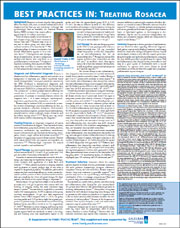
To view the supplement, click the image above.
Topics
• Background
• Diagnosis and Differential Diagnosis
• Treating Rosacea
• Topical Therapy
• Oral Therapy
• Treatment Selection
• Summary
Faculty/Faculty Disclosure
Joseph F. Fowler, MD
Clinical Professor of Dermatology
University of Louisville
Dermatology Specialists PSC
Louisville, KY
Dr. Fowler has received clinical grants from and is a consultant to Galderma, Inc.
Copyright © 2009 Elsevier Inc.
A supplement to Family Practice News. This supplement was supported by Galderma.
•Topics
•Faculty/Faculty Disclosures

To view the supplement, click the image above.
Topics
• Background
• Diagnosis and Differential Diagnosis
• Treating Rosacea
• Topical Therapy
• Oral Therapy
• Treatment Selection
• Summary
Faculty/Faculty Disclosure
Joseph F. Fowler, MD
Clinical Professor of Dermatology
University of Louisville
Dermatology Specialists PSC
Louisville, KY
Dr. Fowler has received clinical grants from and is a consultant to Galderma, Inc.
Copyright © 2009 Elsevier Inc.
A supplement to Family Practice News. This supplement was supported by Galderma.
•Topics
•Faculty/Faculty Disclosures

To view the supplement, click the image above.
Topics
• Background
• Diagnosis and Differential Diagnosis
• Treating Rosacea
• Topical Therapy
• Oral Therapy
• Treatment Selection
• Summary
Faculty/Faculty Disclosure
Joseph F. Fowler, MD
Clinical Professor of Dermatology
University of Louisville
Dermatology Specialists PSC
Louisville, KY
Dr. Fowler has received clinical grants from and is a consultant to Galderma, Inc.
Copyright © 2009 Elsevier Inc.
Diagnosis and Management of Alpha-1 Antitrypsin Deficiency
A supplement to Family Practice News. This supplement was supported by Talecris Biotherapeutics.
•Topics
•Faculty/Faculty Disclosures
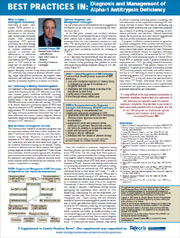
To view the supplement, click the image above.
Topics
•What is Alpha-1 Antitrypsin Deficiency?
•AAT Deficiency is Widely Underrecognized
•Why Are Rates of Diagnosis So Low?
•Optimal Diagnosis and Management Strategies
Faculty/Faculty Disclosures
Faculty/Faculty Disclosures
Leonard Fromer, MD
Assistant Clinical Professor, Family Medicine
David Geffen School of Medicine
University of California
Los Angeles
Dr. Fromer is a consultant for Talecris Biotherapeutics, Inc.
Copyright © 2009 Elsevier Inc.
A supplement to Family Practice News. This supplement was supported by Talecris Biotherapeutics.
•Topics
•Faculty/Faculty Disclosures

To view the supplement, click the image above.
Topics
•What is Alpha-1 Antitrypsin Deficiency?
•AAT Deficiency is Widely Underrecognized
•Why Are Rates of Diagnosis So Low?
•Optimal Diagnosis and Management Strategies
Faculty/Faculty Disclosures
Faculty/Faculty Disclosures
Leonard Fromer, MD
Assistant Clinical Professor, Family Medicine
David Geffen School of Medicine
University of California
Los Angeles
Dr. Fromer is a consultant for Talecris Biotherapeutics, Inc.
Copyright © 2009 Elsevier Inc.
A supplement to Family Practice News. This supplement was supported by Talecris Biotherapeutics.
•Topics
•Faculty/Faculty Disclosures

To view the supplement, click the image above.
Topics
•What is Alpha-1 Antitrypsin Deficiency?
•AAT Deficiency is Widely Underrecognized
•Why Are Rates of Diagnosis So Low?
•Optimal Diagnosis and Management Strategies
Faculty/Faculty Disclosures
Faculty/Faculty Disclosures
Leonard Fromer, MD
Assistant Clinical Professor, Family Medicine
David Geffen School of Medicine
University of California
Los Angeles
Dr. Fromer is a consultant for Talecris Biotherapeutics, Inc.
Copyright © 2009 Elsevier Inc.
